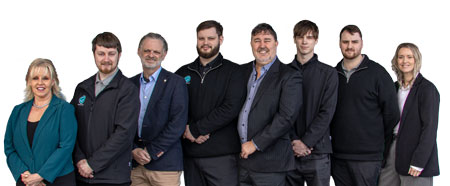Three Reasons To Repair Your Computer
(rather than replace it)
In these tough times with concerns about the environment and the cost of living repairing your computer rather that getting a new one is looking better and better. Let's look at three reasons why...

ONE – It’s cheaper!
Repairing a computer is often a significantly more cost-effective option than replacing it altogether. The economic advantage of repair lies in several factors that collectively contribute to reducing expenses and maximizing the value derived from the existing device. Firstly, the upfront cost of repairing a computer is typically lower than that of purchasing a brand-new replacement. When faced with issues such as a malfunctioning component or software glitches, opting for repair allows individuals to address the specific problem at hand without incurring the substantial expense associated with acquiring a new computer. Repair costs are often limited to the price of replacement parts, labour fees charged by technicians, or DIY repair kits, all of which are generally more affordable than investing in an entirely new device.
Moreover, repairing a computer aligns with a more sustainable approach to resource utilization, thereby indirectly saving costs associated with environmental impact. Electronic waste generated by discarded computers poses significant environmental challenges, including pollution, resource depletion, and energy consumption linked to manufacturing new devices. By choosing to repair rather than replace, individuals contribute to mitigating these environmental costs by extending the lifespan of their existing computer and reducing the demand for new electronic products. This approach not only conserves natural resources but also avoids the expenses incurred by society in managing and mitigating the environmental consequences of electronic waste disposal.
Furthermore, repairing a computer offers a cost-effective means of preserving valuable data and software licenses associated with the device. When replacing a computer, transferring data from the old device to the new one can be a cumbersome and time-consuming process. Additionally, there may be expenses associated with purchasing or renewing software licenses and subscriptions for applications installed on the previous device. By repairing the existing computer, individuals retain access to their data and software without the need for additional expenditures, thereby optimizing cost-efficiency.
Another aspect contributing to the cost-effectiveness of repair is the avoidance of depreciation associated with purchasing new electronic devices. Like most consumer electronics, computers experience depreciation over time, with their monetary value diminishing as newer models are introduced to the market. By repairing a computer instead of replacing it, individuals delay the need to invest in a new device and postpone the depreciation of their initial investment. This delay allows individuals to maximize the utility and value derived from their existing computer, effectively spreading the initial cost of purchase over a more extended period and reducing the overall cost per unit of time.
Moreover, repairing a computer often involves addressing specific issues or components that are malfunctioning or outdated, rather than replacing the entire device. Common repair scenarios include replacing a faulty hard drive, upgrading memory (RAM), or fixing a damaged screen. By targeting and resolving these specific issues, individuals can significantly reduce repair costs compared to the expense of purchasing a new computer with equivalent specifications. This targeted approach to repair enables individuals to allocate their resources more efficiently by focusing on addressing the most critical aspects of their computer's functionality or performance.
In conclusion, the cost-effectiveness of repairing a computer stems from its ability to address specific issues at a lower upfront cost, contribute to environmental sustainability, preserve valuable data and software licenses, avoid depreciation, and target specific components for repair rather than replacing the entire device. By opting for repair over replacement, individuals can optimize the value derived from their existing computer while minimizing expenses, making it a financially prudent decision in many situations.
TWO – It’s better for the Environment
Repairing a computer instead of replacing it offers several environmental benefits that collectively contribute to sustainability and resource conservation. One of the most significant environmental advantages of repair lies in the reduction of electronic waste generation. Discarded computers contribute to the growing problem of e-waste, which poses severe environmental and health hazards due to its toxic components and inefficient disposal methods. By choosing repair over replacement, individuals extend the lifespan of their existing computers, delaying their entry into the waste stream and reducing the overall volume of electronic waste generated. This reduction in e-waste helps mitigate the environmental impact associated with the extraction of raw materials, manufacturing processes, and energy consumption involved in producing new electronic devices.
Furthermore, repairing a computer aligns with the principles of resource efficiency and circular economy by maximizing the utilization of existing resources and minimizing the need for new material inputs. Electronics manufacturing requires significant amounts of energy, water, and raw materials, including rare and precious metals such as gold, silver, and palladium, which are often sourced through environmentally destructive mining practices. By prolonging the lifespan of computers through repair, individuals reduce the demand for new electronic products and alleviate the pressure on natural resources, helping to conserve energy, reduce pollution, and mitigate the ecological footprint associated with electronics production.
In addition to reducing electronic waste and resource consumption, repairing a computer contributes to greenhouse gas emissions reduction by avoiding the carbon footprint associated with manufacturing and transportation. The production of electronics involves energy-intensive processes, including mining, refining, component manufacturing, assembly, and distribution, all of which contribute to greenhouse gas emissions and climate change. By opting for repair instead of replacement, individuals reduce the need for new manufacturing and transportation activities, thereby lowering the carbon emissions associated with the entire lifecycle of electronic products. This reduction in emissions helps mitigate climate change and its adverse impacts on ecosystems, biodiversity, and human well-being, contributing to a more sustainable and resilient environment.
Moreover, repairing a computer fosters a culture of repair and innovation, promoting skills development, knowledge sharing, and technological literacy within communities. Engaging in repair activities encourages individuals to learn about the inner workings of their devices, troubleshoot problems, and develop DIY repair skills, empowering them to take an active role in extending the lifespan of their electronics. This DIY repair culture not only reduces reliance on professional repair services but also fosters a sense of empowerment and self-sufficiency among consumers, leading to more sustainable consumption patterns and reduced electronic waste generation in the long run.
Overall, repairing a computer instead of replacing it offers numerous environmental benefits, including the reduction of electronic waste generation, resource conservation, greenhouse gas emissions reduction, and the promotion of a culture of repair and innovation. By choosing repair over replacement, individuals can contribute to a more sustainable and resilient environment, preserve natural resources, and mitigate the ecological impacts of electronics production and disposal, ultimately helping to build a more sustainable and equitable future for generations to come.
THREE – Less Changes to Your Computer Setup
Repairing a computer rather than opting for a replacement offers a myriad of conveniences and ensures minimal disruption to one's established computer setup. Firstly, repair allows individuals to maintain continuity in their digital workflow without the need for extensive adaptation to new hardware or software configurations. When faced with issues such as hardware malfunctions, software glitches, or system errors, repairing the existing computer enables users to address these problems directly, often without requiring significant changes to their existing setup. This continuity in setup ensures a seamless transition back to normalcy once the repair is complete, minimizing downtime and avoiding the need to reconfigure settings, reinstall software, or transfer data to a new device.
Additionally, repairing a computer preserves familiarity with the existing operating system, software applications, and customization settings, thereby avoiding the learning curve associated with transitioning to a new device. Many users develop a level of proficiency and comfort with their computer setup over time, customizing preferences, organizing files, and configuring software to suit their specific needs and preferences. By repairing the existing computer, individuals can preserve this familiarity and continuity in their digital workspace, avoiding the need to relearn or readjust to a different operating environment, which can be time-consuming and disruptive.
Moreover, repair offers a more streamlined and efficient solution compared to the complexities involved in purchasing, setting up, and migrating data to a new computer. The process of replacing a computer entails various tasks, including researching available options, comparing specifications, purchasing the new device, setting up hardware and software, transferring data, and configuring settings—all of which can be time-consuming and prone to unexpected challenges or complications. In contrast, repairing a computer focuses on addressing the specific issue at hand, whether it's replacing a faulty component, troubleshooting software problems, or optimizing performance, resulting in a more targeted and efficient resolution that minimizes disruptions to one's computer setup.
Furthermore, repairing a computer allows individuals to retain access to their existing data, files, and software licenses, eliminating the need to repurchase or reacquire software applications and subscriptions associated with the previous device. Data migration can be a cumbersome and error-prone process, with the risk of data loss, corruption, or compatibility issues during transfer. By repairing the existing computer, users can preserve their data integrity and continuity, ensuring uninterrupted access to critical files and software without the need for additional expenses or logistical challenges.
In conclusion, repairing a computer offers numerous conveniences and ensures minimal changes to one's established computer setup, including maintaining continuity in workflow, preserving familiarity with operating systems and software, streamlining the repair process, retaining access to existing data and software licenses, and avoiding the complexities of data migration and setup associated with replacing a computer. By opting for repair over replacement, individuals can minimize disruptions, save time and effort, and maintain productivity in their digital endeavours, ultimately enhancing their overall computing experience.
- Thanks to our local friend who wrote this article. Thanks CP.

